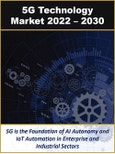5G is the Foundation of AI Autonomy and IoT Automation in Enterprise and Industrial Sectors
Speak directly to the analyst to clarify any post sales queries you may have.
Select Report Findings:
- Over 50% of all new applications will be designed for 5G optimization by 2027
- The combination of 5G and edge computing will lead a revolution in application development
- One of the most important markets for 5G will be private wireless enterprise and industrial networks
- The leading region for 5GNR based applications will be Asia Pac followed by North America (primarily the United States)
- 5G will drive the need for many OSS/BSS upgrades on the part of communication service providers to keep pace with OTT service providers
It is also a new standard that relies upon various supporting technologies including millimeter-wave propagation, IPv6 transmission protocol, and many others including some that are still in the R&D stage with major infrastructure providers. Among other major differences as compared to the fourth generation of cellular, 5G network demands higher data rate in a range of several gigabits per seconds (Gbps) and this can be achieved using steerable antennas with Millimeter Wave (mmWave) technologies.
5G will be based on a transformed Radio Access Network (RAN) and Core Network (CN) for carriers. There were changes with LTE, such as leveraging IP Multimedia Subsystem (IMS) for Voice over LTE (VoLTE). However, the changes with 5G are considerably larger, and the infrastructure is much more purpose-built with an emphasis on a Services Based Architecture (SBA) approach.
This SBA approach will include tight integration with edge computing networks as identified by the European Telecommunications Standards Institute (ETSI) for integration with Multi-access Edge Computing (MEC). This will be deployed in a manner in which MEC supports 5G to preserve the tremendous throughput and latency improvements that will be gained by using 5G versus LTE.
Many enterprise and industrial solutions will emerge that depend upon 5G that were previously impractical due to limitations of other wireless technologies. For example, WiFi is not reliable enough for certain IoT-related applications such as a sensor that wakes up to send a message about critical measurements for industrial equipment.
However, 5G technology (and resulting apps and services) are anticipated to be largely a stepping stone to the 6G technology market. Stated differently, just as 3G did not add substantive value, largely a bridge to 4G/LTE, the research team also sees 5G acting as a catalyst for the 6G market.
The publisher sees a few key reasons including: (1) 5G will have minimal effect in the near-term for the consumer segment, (2) Advanced 5G and edge computing supported private wireless solutions for enterprise and industrial sectors will facilitate innovation in smart buildings, smart factories, and automation in general, and (3) 5G will pave the way for the expansion of immersive technologies (AR, VR, and haptic Internet), but a truly rich user experience will not come until the 6G technology market is fully developed.
With the purchase of this report at the Multi-user License or greater level, you will have access to one hour with an expert analyst who will help you link key findings in the report to the business issues you're addressing. This will need to be used within three months of purchase.
This report also includes a complimentary Excel file with data from the report for purchasers at the Site License or greater level.
Table of Contents
1. Executive Summary
Methodology

LOADING...








